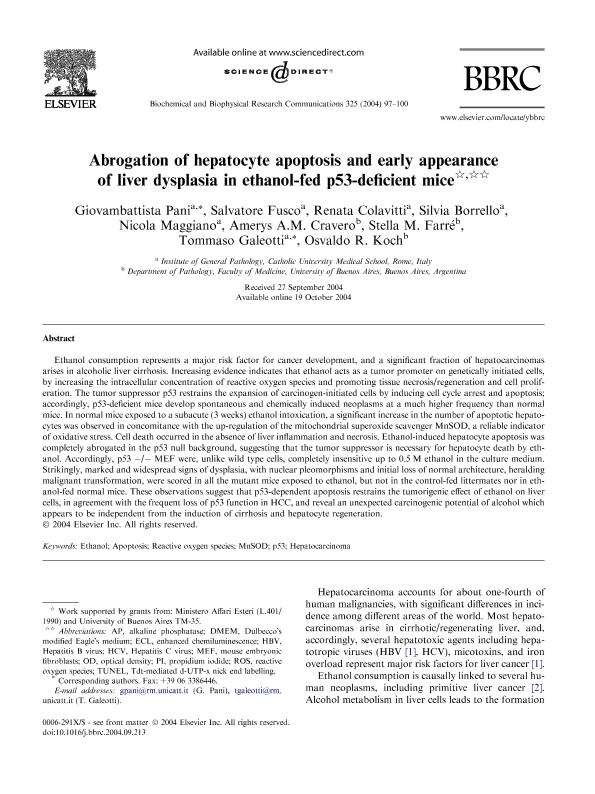Mostrar el registro sencillo del ítem
dc.contributor.author
Pani, Giovambattista
dc.contributor.author
Fusco, Salvatore
dc.contributor.author
Colavitti, Renata
dc.contributor.author
Borrello, Silvia
dc.contributor.author
Maggiano, Nicola
dc.contributor.author
Cravero, Amerys A.M.
dc.contributor.author
Farré, Stella Maris

dc.contributor.author
Galeotti, Tommaso
dc.contributor.author
Koch, Osvaldo Raul

dc.date.available
2022-01-19T16:53:56Z
dc.date.issued
2004-12
dc.identifier.citation
Pani, Giovambattista; Fusco, Salvatore; Colavitti, Renata; Borrello, Silvia; Maggiano, Nicola; et al.; Abrogation of hepatocyte apoptosis and early appearance of liver dysplasia in ethanol-fed p53-deficient mice; Academic Press Inc Elsevier Science; Biochemical and Biophysical Research Communications; 325; 1; 12-2004; 97-100
dc.identifier.issn
0006-291X
dc.identifier.uri
http://hdl.handle.net/11336/150341
dc.description.abstract
Ethanol consumption represents a major risk factor for cancer development, and a significant fraction of hepatocarcinomas arises in alcoholic liver cirrhosis. Increasing evidence indicates that ethanol acts as a tumor promoter on genetically initiated cells, by increasing the intracellular concentration of reactive oxygen species and promoting tissue necrosis/regeneration and cell proliferation. The tumor suppressor p53 restrains the expansion of carcinogen-initiated cells by inducing cell cycle arrest and apoptosis; accordingly, p53-deficient mice develop spontaneous and chemically induced neoplasms at a much higher frequency than normal mice. In normal mice exposed to a subacute (3 weeks) ethanol intoxication, a significant increase in the number of apoptotic hepatocytes was observed in concomitance with the up-regulation of the mitochondrial superoxide scavenger MnSOD, a reliable indicator of oxidative stress. Cell death occurred in the absence of liver inflammation and necrosis. Ethanol-induced hepatocyte apoptosis was completely abrogated in the p53 null background, suggesting that the tumor suppressor is necessary for hepatocyte death by ethanol. Accordingly, p53 -/- MEF were, unlike wild type cells, completely insensitive up to 0.5 M ethanol in the culture medium. Strikingly, marked and widespread signs of dysplasia, with nuclear pleomorphisms and initial loss of normal architecture, heralding malignant transformation, were scored in all the mutant mice exposed to ethanol, but not in the control-fed littermates nor in ethanol-fed normal mice. These observations suggest that p53-dependent apoptosis restrains the tumorigenic effect of ethanol on liver cells, in agreement with the frequent loss of p53 function in HCC, and reveal an unexpected carcinogenic potential of alcohol which appears to be independent from the induction of cirrhosis and hepatocyte regeneration.
dc.format
application/pdf
dc.language.iso
eng
dc.publisher
Academic Press Inc Elsevier Science

dc.rights
info:eu-repo/semantics/openAccess
dc.rights.uri
https://creativecommons.org/licenses/by-nc-sa/2.5/ar/
dc.subject
APOPTOSIS
dc.subject
ETHANOL
dc.subject
HEPATOCARCINOMA
dc.subject
MNSOD
dc.subject
P53
dc.subject
REACTIVE OXYGEN SPECIES
dc.subject.classification
Gastroenterología y Hepatología

dc.subject.classification
Medicina Clínica

dc.subject.classification
CIENCIAS MÉDICAS Y DE LA SALUD

dc.title
Abrogation of hepatocyte apoptosis and early appearance of liver dysplasia in ethanol-fed p53-deficient mice
dc.type
info:eu-repo/semantics/article
dc.type
info:ar-repo/semantics/artículo
dc.type
info:eu-repo/semantics/publishedVersion
dc.date.updated
2021-12-03T20:54:27Z
dc.journal.volume
325
dc.journal.number
1
dc.journal.pagination
97-100
dc.journal.pais
Estados Unidos

dc.description.fil
Fil: Pani, Giovambattista. Università Cattolica del Sacro Cuore; Italia
dc.description.fil
Fil: Fusco, Salvatore. Università Cattolica del Sacro Cuore; Italia
dc.description.fil
Fil: Colavitti, Renata. Università Cattolica del Sacro Cuore; Italia
dc.description.fil
Fil: Borrello, Silvia. Università Cattolica del Sacro Cuore; Italia
dc.description.fil
Fil: Maggiano, Nicola. Università Cattolica del Sacro Cuore; Italia
dc.description.fil
Fil: Cravero, Amerys A.M.. Universidad de Buenos Aires; Argentina
dc.description.fil
Fil: Farré, Stella Maris. Universidad de Buenos Aires; Argentina
dc.description.fil
Fil: Galeotti, Tommaso. Università Cattolica del Sacro Cuore; Italia
dc.description.fil
Fil: Koch, Osvaldo Raul. Universidad de Buenos Aires. Facultad de Medicina; Argentina. Consejo Nacional de Investigaciones Científicas y Técnicas. Oficina de Coordinación Administrativa Houssay; Argentina
dc.journal.title
Biochemical and Biophysical Research Communications

dc.relation.alternativeid
info:eu-repo/semantics/altIdentifier/url/https://www.sciencedirect.com/science/article/abs/pii/S0006291X04022727
dc.relation.alternativeid
info:eu-repo/semantics/altIdentifier/doi/http://dx.doi.org/10.1016/j.bbrc.2004.09.213
Archivos asociados
